Whether you’ve just changed your guitar strings or are getting ready to remove your old set, you’re going to need to know how to cut your guitar strings.
Guitar strings are made of metal wire, which can be tough to get through. But, with the right tools, it’s quick and easy work.
But, even if you don’t have the right tools, you still might be able to cut your strings using some household items. In fact, I did some research by cutting guitar strings with a few everyday household items and I’ve shared the results in this article!
Affiliate disclaimer: This page contains affiliate links for products that I’ve tried and tested. As an Amazon Associate I earn from qualifying purchases at no additional cost to you. Learn more here.
How to cut guitar strings
The best way to cut guitar strings for electric, acoustic, and bass guitar, is by using wire cutters. A wire cutter is an inexpensive tool that has sharpened blades and a lot of power – kind of like a bird beak.
These handy devices effortlessly cut through strings with a simple snip, making removing excess strings (or removing the strings themselves) a quick and easy job.
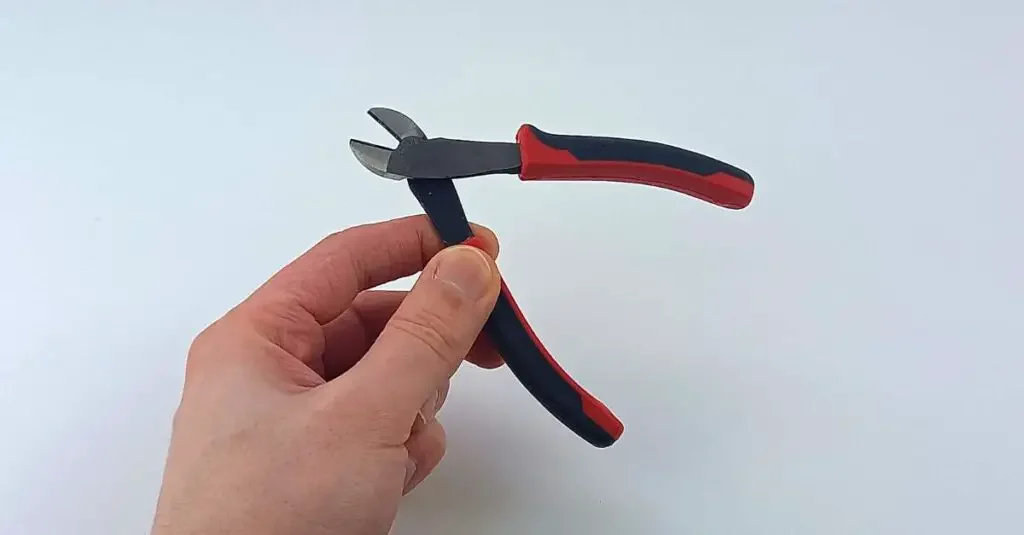
What’s great about wire clippers is that they have a flat side, which helps you get really close to the string when cutting off any excess.
The wire clippers I use came as part of a guitar maintenance kit that I’d recommend checking out, as it contains all the tools you’ll need for future regular guitar DIY jobs. You can find it here on Amazon.
But, if you’re just looking for some dedicated wire cutters, then I’d recommend picking up a D’Addario string cutter on Amazon. It’s a multi-tool that also include a string winder – which is really useful when changing your guitar strings.
Cutting your strings
To cut your guitar strings, simply open the wire cutters and clip the string by squeezing the wire cutters closed – almost like using a pair of scissors. Guitar strings can be a bit tough, so you might need to squeeze the wire cutters hard, or with two hands, to get the job done – especially for thicker bass strings.
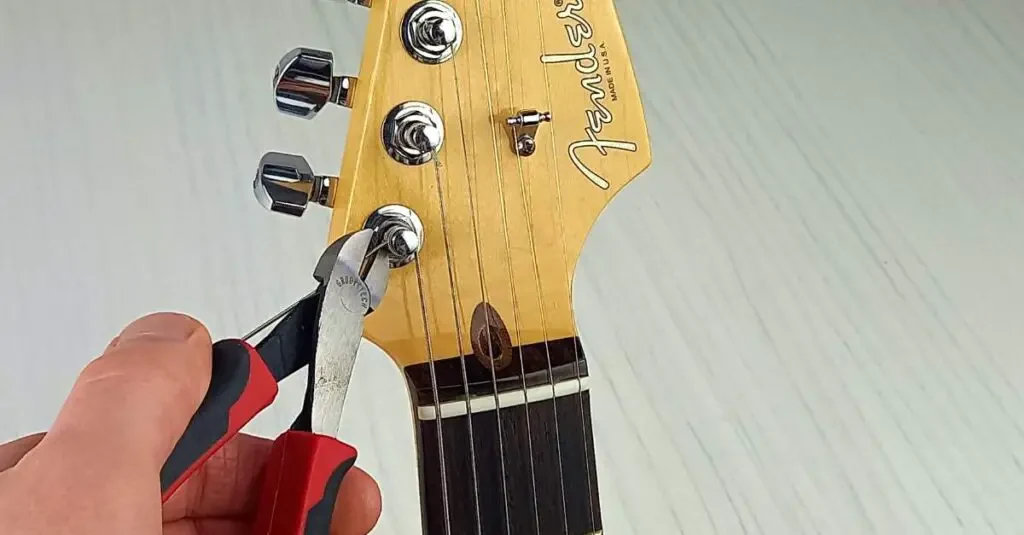
If you’re cutting off the excess string after a string change, I recommend facing the flat side of the wire cutters towards the tuning post. In my experience, this results in a tighter cut that removes more of the string.
If you’re changing your guitar strings and are cutting the old strings off: make sure that you fully loosen the strings and that they are completely slack before cutting them. Otherwise, the sudden change in tension can damage your guitar’s neck, nut, or bridge. Not only this, but guitar strings hold a lot of tension and they could ping out and hurt you.
Where should you cut your guitar strings?
If you’ve changed your guitar strings and are cutting the excess string, then I recommend cutting it as close to the tuning post as you can – leaving at most a ¼ inch.
Why? Because leaving too much excess string can get in the way when you’re tuning. Strings are also quite pointy, so getting them out of the way of your hands will keep them safe and scratch free.
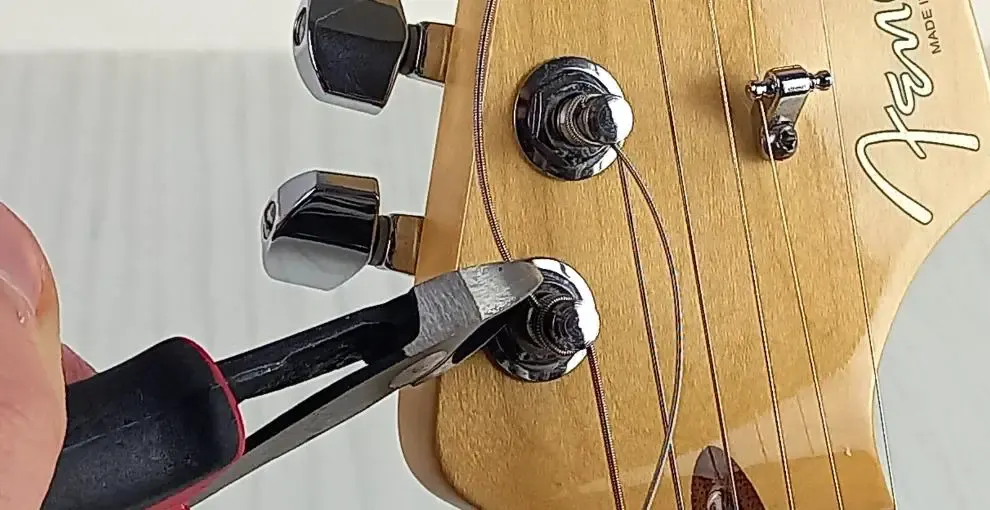
You’ll also want to be careful when cutting your strings to make sure that you don’t accidentally cut any of the string that’s wound around the post. Otherwise, your entire string will come unwound and you’ll have to install a new one.
But, you may not even want to cut your strings! Some guitarists, like Tom Morello, don’t cut the strings at the top of the headstock. This is an aesthetic choice, and leans into a punk-rock image. If you don’t want to cut your strings – that’s your choice!
Personally, I went through a phase of not cutting my strings. I found that the strings dug into the inside of my guitar case and poked holes in the lining. Not only that, but they also just got in the way when tuning – and I felt like they might poke me in the eye! So, it may look cool, but it’s not always the most practical choice!
If you’re changing your guitar strings and cutting your strings off your guitar then I recommend cutting them around the 12th fret.
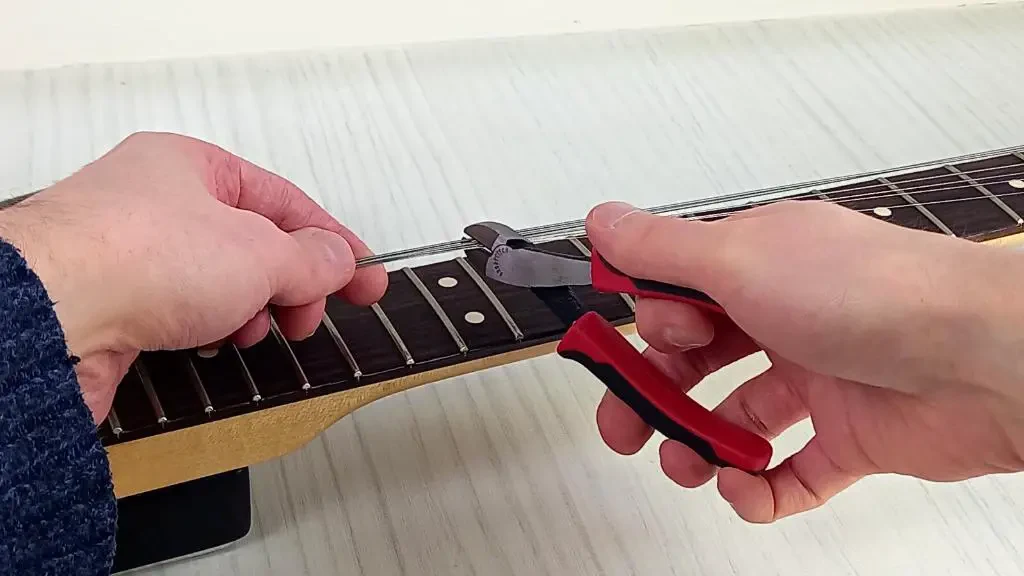
This leaves plenty of string to push through your bridge (especially if you have a through-body guitar like a Stratocaster). Again, it’s very important that your stringsare fully loosened before cutting them off your guitar.
How to cut guitar strings without wire cutters
Not all of us have the necessary tools for cutting guitar strings laying around the house… or do we? If you’re in a bit of a bind and need to get those strings cut, then here’s a few household items that you can use to cut your guitar strings.
I’ve tested each one of these out by testing them with a set of old strings – with mixed results! For each item, I tested cutting both a gauge 42 wound string, and a gauge 9 plain string.
Before I get into the results, I strongly recommend picking up the right tool for the job. In my experience with testing the household solutions, they all took longer to cut the strings and were harder to use compared to wire cutters.
If you can wait a day or two, just buy a pair of wire cutters. They’re cheap, easy to use, and are much better for the job than these other tools.
Important: Don’t use any open blade tools to cut your guitar strings. By this I mean a knife, saw, or anything with a single open-faced blade. Not only do you risk scratching your guitar, but it’s also dangerous for you. Guitar strings are tough and can be slippy – both of which risk causing an accident!
Nail clippers
Most people will have a pair of nail clippers laying around. These put out a lot of pressure and are surprisingly useful at cutting through guitar strings.
In fact, I’d rank them as the best tool to use if you don’t have any wire cutters laying around.
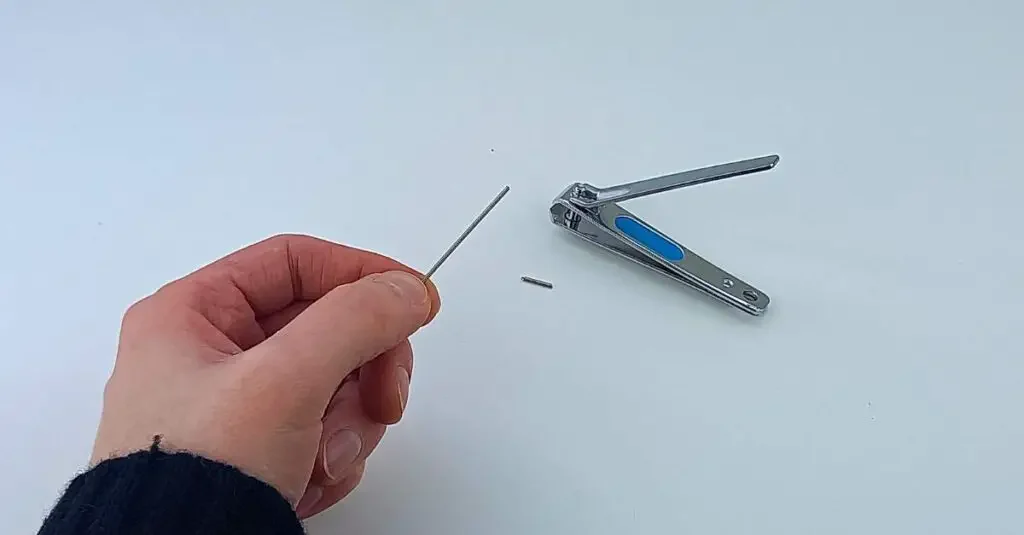
Why? In my experiment, they were able to cut through both the thick wound string and thin plain string with relative ease. It took me by surprise!
They’re also nimble enough to get close to clip the string close to the tuning peg – which will remove most of the excess.
It’s worth noting, though, that these are heavy duty clippers. Smaller fingernail clippers may not provide enough power to clip your strings.
You’ll also want to make sure that you don’t damage the nail clippers – as the strings can put up a fight and deform the bladed tip. While they’re my top pick, I still recommend just picking up a pair of wire cutters – otherwise you might also have to add a replacement set of nail clippers to your list!
Scissors
Heavy duty scissors, like kitchen scissors, are able to cut through guitar strings. I was able to get through both a gauge 42 string wound string and a gauge 9 plain string. Though, I found I had to give it a few goes before I got through the thicker string, and I had to work the end off with my fingers.
Unfortunately, craft scissors and salon-style scissors won’t cut it (pun fully intended). These scissors could barely cut through the gauge 9 string and didn’t make a dent in the 42 gauge string.
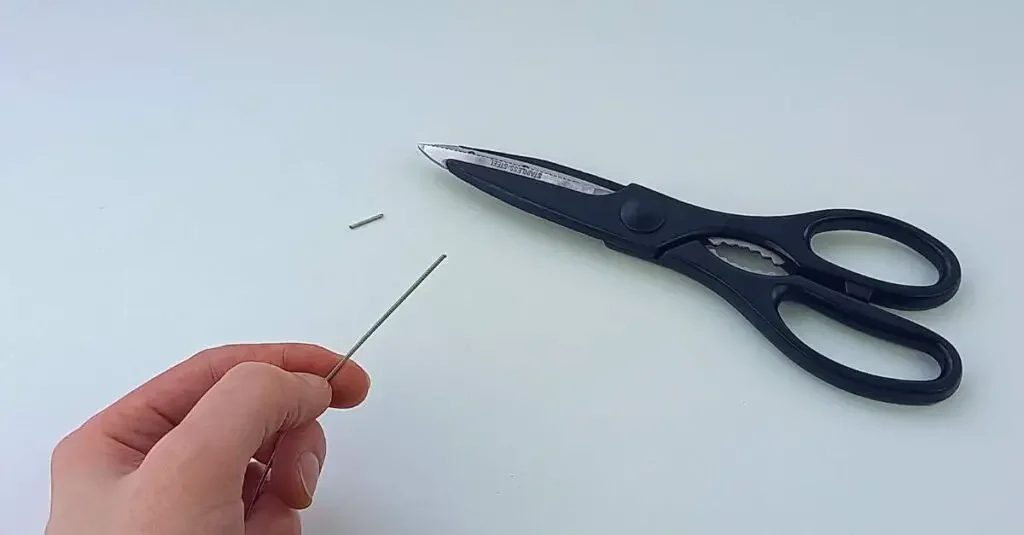
I found that the trick to cutting a guitar string with scissors is to move the string as close to the base of the scissors as you can. This gives you the most power and control, and requires less effort from you to cut.
That being said, the strings are going to put up a fight and you risk dulling the blades of your scissors – mine certainly did!
Garden shears
Do you have a gardener in your life? Then you might have access to a pair of garden shears. I’m talking about the handheld shears – not the huge hedge trimming ones!
These things are designed to handle thick branches, so they should be more than capable of cutting through your guitar strings. But, in my test, I found that these shears struggled with the thinner strings as they couldn’t get enough pressure on them.
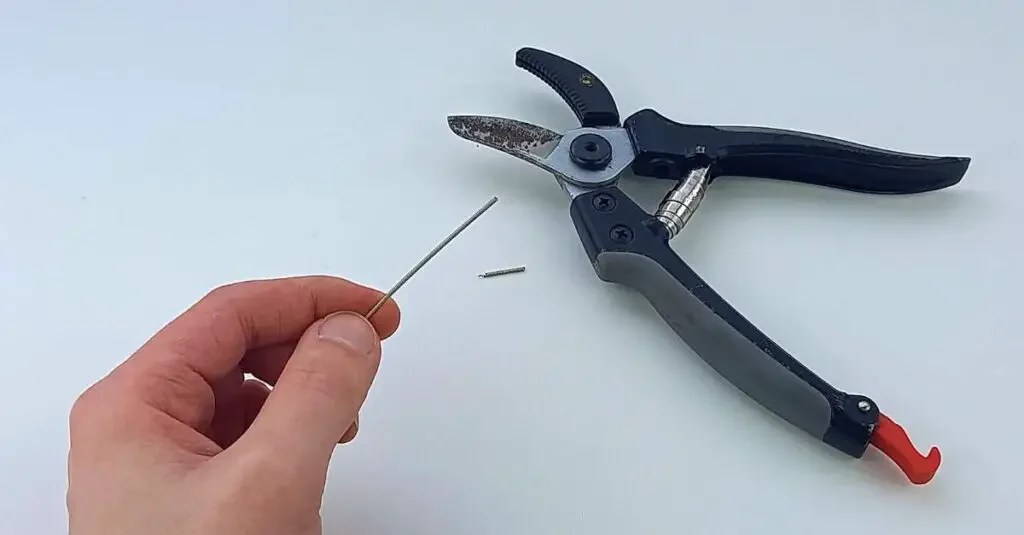
After repeatedly trying to cut the string, it did eventually weaken it to the point where the string fell off. But, it wasn’t an easy job!
Also, it’s worth making sure that you’ve cleaned them before cutting your strings – you don’t want to get any dirt or grime on your precious axe.
Pliers
If you have a tool kit laying around, then you probably have access to a pair of pliers – sometimes called wire grippers.
While these devices are mostly used for grabbing onto and controlling wires, most come with a clipping functionality towards the base of the blades. Simply slide the string into the base of the pliers and squeeze.
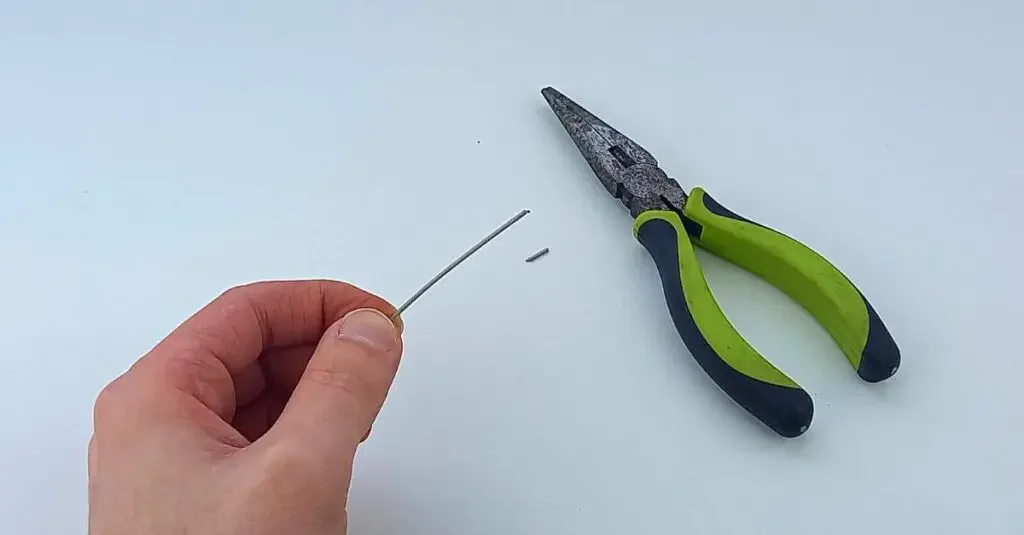
In my test, these were able to handle both the thicker and thinner strings with relative ease. Still, if you have some pliers, you’ll probably already have some wire cutters, too!
Again, pliers aren’t ideal as they’re quite bulky, which makes it harder to get a close trim – but it’ll do the job in a pinch.
Bending the string
This is the least accurate way of removing the string and, in my opinion, was definitely the most frustrating method on this list. It should only be used as a last resort.
Whenever you bend a string it becomes weaker, which is one of the reasons that guitar strings break. You can take advantage of this by creating a sharp bend in the string excess and repeatedly bending it backwards and forwards using your hand.
Eventually, the string will snap – but it’ll take a while. It took me several minutes to get my strings to break by bending them.
This method will definitely put undue stress on your guitar. But, if you don’t have any other choice, then it’ll work.
Final thoughts
Cutting your guitar strings is an important part of guitar maintenance, so it’s important to know how to do it – and do it properly.
While I’ve given you six ways that you can trim your strings, I only recommend one: using a pair of string cutters as they’re the proper tool for the job. Again, you can check out this pair here on Amazon.
Using string cutters will give you a better result, save you time, and reduce the risk of damage to you, your strings, and your guitar!

Conor is a music producer, multi-instrumentalist, and all-round enthusiast from the UK with over 15 years of experience. He’s the founder and sole-content creator for the roundtable audio blog and YouTube channel.
